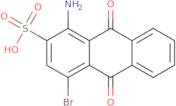1-Amino-4-bromo-9,10-dioxo-9,10-dihydroanthracene-2-sulfonic acid
CAS: 116-81-4
Ref. 3D-AAA11681
| 5g | Discontinued | ||
| 10g | Discontinued | ||
| 25g | Discontinued | ||
| 50g | Discontinued | ||
| 100g | Discontinued |
Product Information
- 1-Amino-2-sulfonato-4-bromo-9,10-anthraquinone
- 1-Amino-4-Bromo-9,10-Dioxo-9,10-Dihydroanthracene-2-Sulfonic Acid
- 1-Amino-4-bromo-9,10-dihydro-9,10-dioxo-2-anthracenesulfonic acid
- 1-Amino-4-bromo-9,10-dioxo-9,10-dihydro-anthracene-2-sulfonic acid
- 1-Amino-4-bromo-9,10-dioxo-9,10-dihydroanthracene-2-sulfonicacid
- 1-Amino-4-bromo-9,10-dioxoanthracene-2-sulfonic acid
- 1-Amino-4-bromoanthraquinone-2-sulfonic acid
- 2-Anthracenesulfonic acid, 1-amino-4-bromo-9,10-dihydro-9,10-dioxo-
- 2-Anthraquinonesulfonic acid, 1-amino-4-bromo-
- 4-Bromo-1-aminoanthraquinone-2-sulfonic acid
- See more synonyms
- Alizarine Cyanol Grey G
- Bramaminic Acid
- Bromaminic Acid
- NSC 7574
- Bromamine acid
1-Amino-4-bromo-9,10-dioxo-9,10-dihydroanthracene-2-sulfonic acid is a reactive substance that can be used in wastewater treatment. It reacts with nitrogen atoms from the water to form ammonium ions and nitrates. 1-Amino-4-bromo-9,10-dioxo 9,10 -dihydroanthracene 2 sulfonic acid also reacts with sodium carbonate to form sodium bicarbonate and 1,3 dioxane. The bacteria strain Pseudomonas putida was found to use this compound as an electron acceptor for respiration and as a nitrogen source for growth. 1,3 Dioxane is generated during this process and can be removed by condensation with magnesium salts. This substance has synergistic effects when combined with polarizers such as activated clay or zeolites.





